-
Posts
129 -
Joined
-
Last visited
-
Days Won
1
Content Type
Profiles
Forums
Downloads
Gallery
Posts posted by Wouter
-
-
I disagree! I like the concept. But I think it would be much more suitable for kids to learn like this then adults.
-
VI Name:
IP Validation
Total VIs:
strpos.vi, strrpos.vi, substr_count.vi, valid_ipv6.vi, test,vi, unittest.vi, ip2long.vi, long2ip.vi, valid_ipv4.vi
Description:
I saw in the svn of OpenG that there was a candidate for IP validation. But however I think I have a better one. One for IPv4 and one for IPv6, credits for the IPv6 algo goes to http://crisp.tweakbl...d-caveats).html
Note:
-
Blockdiagram:
-
What are you thoughts on this VI?
- Would you like to see such a function in OpenG?
- Can you optimize the code?
- In which package should it be included?
- Should it be rejected?
-edit- ups I forgot to set the unittests data I inputed in the control as default value... well you can now enter them by hand.
$unitTests = array( '2001:0db8:0000:0000:0000:0000:1428:57ab' => true, '2001:0DB8:0000:0000:0000:0000:1428:57AB' => true, '2001:00db8:0000:0000:0000:0000:1428:57ab' => false, '2001:0db8:xxxx:0000:0000:0000:1428:57ab' => false, '2001:db8::1428:57ab' => true, '2001:db8::1428::57ab' => false, '2001:dx0::1234' => false, '2001:db0::12345' => false, '' => false, ':' => false, '::' => true, ':::' => false, '::::' => false, '::1' => true, ':::1' => false, '::1.2.3.4' => true, '::256.0.0.1' => false, '::01.02.03.04' => false, 'a:b:c::1.2.3.4' => true, 'a:b:c:d::1.2.3.4' => true, 'a:b:c:d:e::1.2.3.4' => true, 'a:b:c:d:e:f:1.2.3.4' => true, 'a:b:c:d:e:f:1.256.3.4' => false, 'a:b:c:d:e:f::1.2.3.4' => false, 'a:b:c:d:e:f:0:1:2' => false, 'a:b:c:d:e:f:0:1' => true, 'a::b:c:d:e:f:0:1' => false, 'a::c:d:e:f:0:1' => true, 'a::e:f:0:1' => true, 'a::e:f:0:1' => true, 'a::f:0:1' => true, 'a::0:1' => true, 'a::1' => true, 'a::' => true, '::0:1:a:b:c:d:e:f' => false, '::0:a:b:c:d:e:f' => false, '::a:b:c:d:e:f' => true, '::b:c:d:e:f' => true, '::c:d:e:f' => true, '::e:f' => true, '::e:f' => true, '::f' => true, '0:1:a:b:c:d:e:f::' => false, '0:a:b:c:d:e:f::' => false, 'a:b:c:d:e:f::' => true, 'b:c:d:e:f::' => true, 'c:d:e:f::' => true, 'd:e:f::' => true, 'e:f::' => true, 'f::' => true, 'a:b:::e:f' => false, '::a:' => false, '::a::' => false, ':a::b' => false, 'a::b:' => false, '::a:b::c' => false, 'abcde::f' => false, '10.0.0.1' => false, ':10.0.0.1' => false, '0:0:0:255.255.255.255' => false, '1fff::a88:85a3::172.31.128.1' => false, 'a:b:c:d:e:f:0::1' => false, 'a:b:c:d:e:f:0::' => false, 'a:b:c:d:e:f::0' => true, 'a:b:c:d:e:f::' => true, 'total gibberish' => false);
- Would you like to see such a function in OpenG?
-

Further I was thinking about the following... do we need to add point-to-point means? For each one of them?
-
Because Altenbach also wanted the VI to work for complex numbers... some reading material: http://faculty.sfasu...plexNumbers.PDF
Further... what about the geometric mean, harmonic mean, quadratic mean, weighted mean, truncated mean, midrange, http://en.wikipedia....i/Average#Types
-
http://forums.openg.org/index.php?showtopic=820
http://wiki.openg.org/Arithmetic_Mean_(Functional_Spec)
From the old fora's
I believe there wasn't made any decision yet... was there?
-
 1
1
-
-
Do you really need the voltage level? Or do you only need a indicator for the how much % of the battery level remains. If the latter you can just use the "GetSystemPowerStatus" function, it also returns the % level of the battery.
If not you can use PowerReadACValue; msdn.microsoft.com/en-us/library/windows/desktop/aa372734(v=VS.85).aspx
or PowerReadDCValue; msdn.microsoft.com/en-us/library/windows/desktop/aa372737(v=VS.85).aspx
for all power management functions you can look here: msdn.microsoft.com/en-us/library/windows/desktop/aa373163(v=VS.85).aspx
-
Thanks for your post, with a clear overview of the benefits.
Most of the stuff I readed @ http://zone.ni.com/devzone/cda/tut/p/id/3727 (sorry had to read first before asking
 ), it then made me more curious about the disadvantages... because how NI describes it, it is the best format available
), it then made me more curious about the disadvantages... because how NI describes it, it is the best format available  which I doubt.
which I doubt. 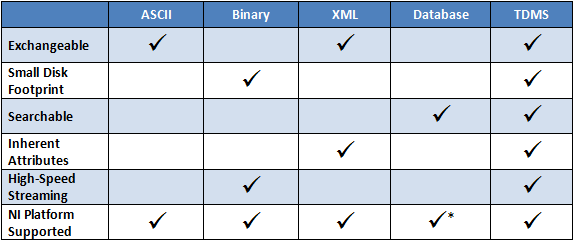
-
Poly VI with CRC8, CRC16-CCITT (0x000, 0x1D0F, 0xFFFF), CRC-IBM, CRC32
Some reading material:
http://en.wikipedia.org/wiki/Cyclic_redundancy_check
http://www.pvlteam.com/doc/crc/algos.htm
http://www.miscel.dk/MiscEl/CRCcalculations.html
http://web.archive.org/web/20071221025748/http://www.joegeluso.com/software/articles/ccitt.htm
-
 1
1
-
-
Other question... I don't really know anything about TDMS... But why save data in those files?
-
-
-
@Ton: you mean the hamming weight... http://en.wikipedia.org/wiki/Hamming_weight, and yes.
not the hamming distance ;-) http://en.wikipedia.org/wiki/Hamming_distance
-
@Ton, in the rfc1952 they even use unsigned long. So I would earlier change it to u64 then u8

-
Question what exactly needs to be done before the code gets reviewed for OpenG? I guess that the diagrams need some cleaning up. But anything else?
-
VI Name:
CRC32
Total VIs:
3
Description:
I was suprised LabVIEW didn't had the CRC32. So I made it, http://en.wikipedia.org/wiki/Cyclic_redundancy_check, http://www.ietf.org/rfc/rfc1952.txt. It can take a array of U32, one element of U32 or a string. When needed I can create more CRC checks, CRC8, CRC16, etc... but CRC32 is the most used one I readed.
Note:
-
Blockdiagram:
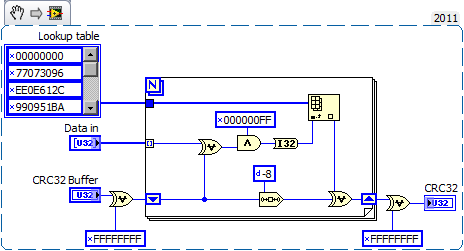
What are you thoughts on this VI?
- Would you like to see such a function in OpenG?
- Can you optimize the code?
- In which package should it be included?
- Should it be rejected?
- Would you like to see such a function in OpenG?
-
Euh ontopic
 ?
? -
VI Name:
SliceString
Total VIs:
2
Description:
The slice string should in my opinion by revised. Currently it is not doing as the name implies it thus. Because it only fetches the subset of a string, which can already be done by the "string subset" function in LabVIEW, the only thing it really does is calculating the length. Because one gives 2 indices, i:j, then length is j-i.
My two VI's are different. They accept a array of indices and then slice them on those places and index the results in a array of strings. Further the other VI accepts a numeric input and then slices the string after each repetition. The end VI should be polymorfic. (The slice string by reptition is in fact the same as the StringToChar function.
Note:
-
Blockdiagram:
Slice string by indices
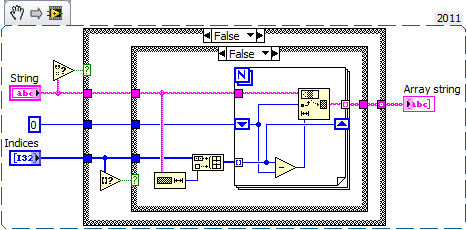
Slice string by repitition

What are you thoughts on this VI?
-
Would you like to see such a function in OpenG? -
Can you optimize the code? -
In which package should it be included? -
Should it be rejected?
ps. the snippts are in 2011, the VI's in 2009
-
-
-
Okay, well here are the VI's then :-) (I could not edit the opening posts)
-
VI Name:
Numeric to binary string and binary string to numeric
Total VIs:
2
Description:
Conversion of numeric to binary string, and binary string back to numeric
Note:
Could be a good wrapper in my opinion.
Blockdiagram:
Binary string to numeric:

Numeric to binary string (from: https://decibel.ni.com/content/docs/DOC-5782)
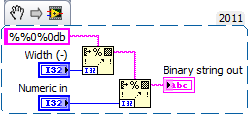
What are you thoughts on this VI?
- Would you like to see such a function in OpenG?
- Can you optimize the code?
- In which package should it be included?
- Should it be rejected?
-
 1
1
- Would you like to see such a function in OpenG?
-
VI Name:
Hamming Weight and Hamming Distance
Total VIs:
2
Description:
One VI calculates the hamming weight, the other the hamming distance,
Note:
-
Blockdiagram:
Hamming weight (two versions, one with parallel loop, other without, didn't tested which one was faster)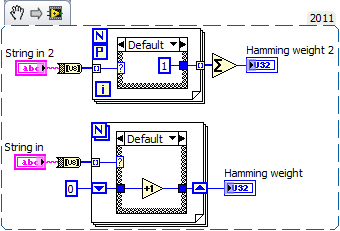 Hamming distance:
Hamming distance: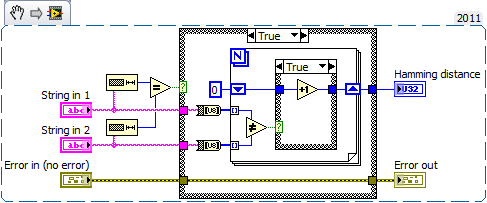 What are you thoughts on this VI?
What are you thoughts on this VI?- Would you like to see such a function in OpenG?
- Can you optimize the code?
- In which package should it be included?
- Should it be rejected?
- Would you like to see such a function in OpenG?
-
For this particulary example I disagree with you. Comment is good, but all the comments in this particular example are in my opinion not needed since the code is very straight forward.
When coding in C I wouldn't either comment code like "lenVariable = strlen(strVariable) // get the length of the string"
In my opinion only parts of code which are not that straightforward, certain parts of a algorithm, should be documented. When all the parts of the algorithm are straightforward, as in this case, the only thing that needs to be documented is what the algorithm exactly does, which is already done in this case.
Of course one could discuss about what the exact definition is of straightforward.
-
 1
1
-
-
I also just checked and can't seem to find it underneath LabVIEW 2011??
-



LabVIEW can generate QR code or not.
in LabVIEW General
Posted
There are several .dll availables for .NET. You can use them also in LabVIEW. http://www.google.nl/search?q=qr+code+generator+dll. Further when you google on "ISO/IEC 18004:2006" you may or may not find a .PDF file containing the ISO/IEC specification of QR code, enabling you to fully implement QR code in LabVIEW. However note that the .PDF is actually not the latest edition "ISO/IEC 18004:2006" but the previous "ISO/IEC 18004:2000".